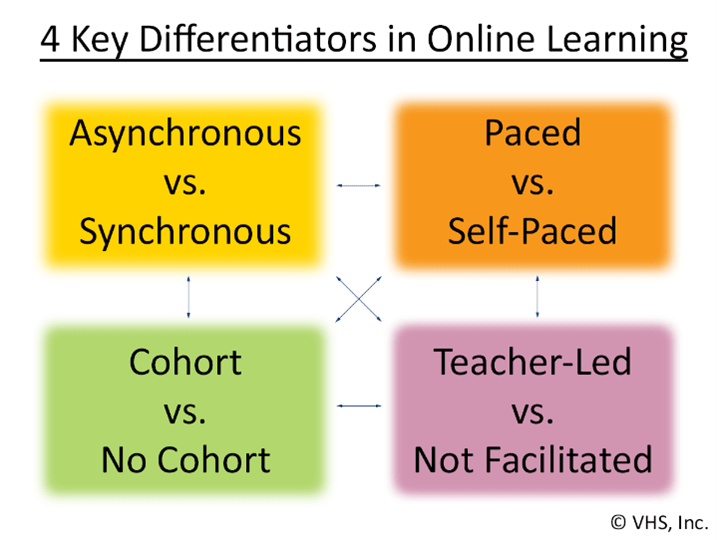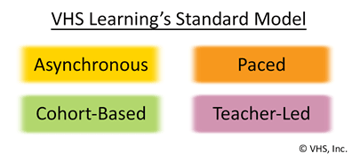Online Learning 101, Part 1: All Online Learning is NOT the Same
The global pandemic forced many schools around the world to turn to online learning. Hundreds of millions of students, teachers and school administrators tried their best to keep the boat moving through rough, scary waters. For most students and teachers, the definition of “online learning” became synonymous with a synchronous model, with scheduled sessions using video conferencing tools like Zoom. Basically, trying to replicate the face-to-face approach over computer screens and digital devices.
From a “cup is half-full” perspective, it is nothing short of miraculous that so many around the world were able to use technology to keep student learning going. Just consider for a moment if the pandemic happened decades ago, before streaming video and smartphones were ubiquitous. How would schools have continued to educate their students? (It’s important to note here that there are, in fact, many places around the world that did not have the technological infrastructure to deliver learning online during the Covid-19 pandemic and were left behind. Those of us in locales with the necessary technological infrastructure must not take this for granted.)
Okay—now the “cup is half-empty” perspective: Online learning during the pandemic has been a huge challenge for many—often a total train wreck. To be fair, teachers tried valiantly to adapt to entirely new ways of instruction with little-to-no training and should all be given gold medals for their efforts. Still, for many, there have been significant gaps in learning. Such loss has often led to significant consequences in other areas, deeply affecting the social and emotional well-being of both students and teacher.
There’s another “half-empty” consequence—one that we at VHS Learning and like-minded educational organizations have felt with the force of a gut punch: “Online learning” has gotten a bad name. Many unfamiliar with online learning who may be experiencing it for the first time have lumped all of “Online Learning” into one bucket, and it’s not a pretty bucket! But the fact is, there are many, many combinations of ways to deliver learning online, each with their own strengths and limitations. In many cases, trying to compare or lump together different delivery models is like comparing apples to oranges.
And so, as an attempt to begin to repair the good name of online learning, and to bring some much-needed nuance to understanding the variety of online learning delivery models out there, I’ve outlined four key differentiators:

- Asynchronous vs. Synchronous: In a fully asynchronous online classroom, there are no live, scheduled classes. Any group work, such as discussions, take place over time and usually through written communication. Synchronous online learning means live, scheduled classes and/or tutoring through video conferencing tools like Zoom.
- Paced vs. Self-Paced: In a paced online classroom, students go through the scope and sequence following a specific schedule. Assignments must be completed by specified dates and there are penalties for late work. Typically, paced courses have a set of assignments due each week. In a self-paced online course, students proceed through the course materials and complete activities and assignments at their own individual pace and discretion.
- Cohort vs. No Cohort: In a cohort-based online classroom, a specific group of students will proceed through the course together, with an emphasis on group work and community building. In a non-cohort-based online course, the students proceed through the curriculum themselves with an emphasis on individualized activities.
- Teacher-Led vs. Not Facilitated: In a teacher-led online classroom, there is usually a manageable student-teacher ratio, and the teacher uses strategies to foster a learning community. The teacher also provides customized feedback and communicates directly with students to help resolve issues. In an online classroom that is not facilitated, the onus is on the student to proceed through the curriculum and complete activities, and any student work is auto graded.
Here’s the thing: Those of you math-oriented readers out there will have immediately concluded that in the graphic above, there are sixteen possible combinations for different ways to deliver online learning. In reality, many programs take a hybrid approach, incorporating several options simultaneously, increasing that number exponentially.
If you take nothing else away from this article, I hope at least you will never again look at online learning as “just one thing.” In Part 2 of this two-part blog, I will take a deeper dive to talk about two of the differentiators that often get grouped together: asynchronous online learning and self-paced online learning. Spoiler alert: They are NOT always the same thing.
John Englander is Program Officer for VHS Learning. He is responsible for overseeing special projects and pursuing research and evaluation opportunities on VHS Learning's program and pedagogic approach. He also works with foundations and educational organizations to develop partnerships that expand the reach of VHS Learning's mission to provide students and teachers with collaborative and engaging learning opportunities.

/Computer-Lab_VHS13875.jpg?width=352&name=Computer-Lab_VHS13875.jpg)
